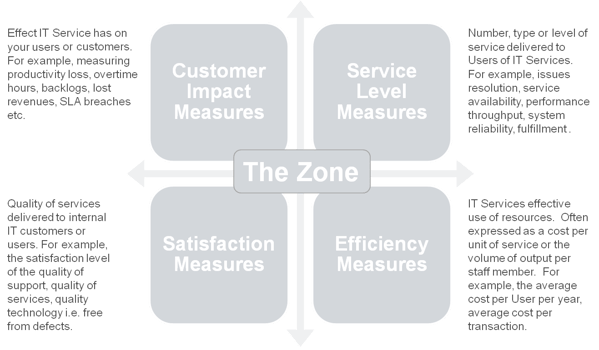Service Providers under Pressure to find Competitive Advantage
Knowing how your customers value your services is key to success. Sometimes it’s tough to find the perfect blend of reliable service delivery with good quality and for the right cost. Finding your optimal mix “the zone” gives you significant advantage to win new customers and keep them delighted.
Occasionally customers and service providers have different opinions of what value is. Getting the right mix of benefits, features, quality, guarantees and costs is paramount to happy customers and a good night’s sleep. Let’s call this right mix “the zone”. You want to be in the zone at all times. Focus too much in one area, say low cost, you risk other areas, like quality. As the old expression goes “Good, fast or cheap; pick two”. You get the point.
Get in the Zone and Create your Advantage
This article presents some ideas, techniques, tips, tricks and best practices to help you improve your services value proposition. That is, maximum value for the right cost, delivery and quality. See how to measure, learn and improve your services value proposition for competitive advantage.

What is Customer Value
Value is in the eye of the beholder which simply means “it depends on who you ask and when you ask them”. Value is often personal and based on perceptions of what’s important to your customers. Some questions need to be answered. How does your service address what’s important to you customer? Specifically, what is the benefit or positive outcome they will get from your service? Will they be more successful, save money, be more productive, reduce risks, sleep better at night, have more personal time, get a raise, get recognition, win Nobel peace prize etc.? Does it help meet their goals and objectives? How does your service impact your customer in terms of their benefits or positive outcomes?
What is a Service
A service is a means of acquiring an end result without the hard work or risks. This typically means paying someone else (expert with tools) for guaranteed (no risk) instant gratification (the benefits). For example, you (the customer) need to get to work (important goal) on time, safely and for a reasonable cost (objectives). Your choices are taking the bus or driving a car. Bus = public transit service, car = ownership of a depreciating asset + driver's license + experience driving a car + up to date insurance and license tags + hassle of negotiating rush hour traffic + gas, repairs, car washes etc.. Services are intangibles; you can’t touch or see them. You experience them. Because of this they often come with service level guarantees to set your expectation of what you should experience. These are fondly referred to as service levels.
Why Customer Satisfaction is Important
Customer satisfaction is the measure of how well expectations were met. Expectations are from different perspectives like outcomes were achieved; actual experience was as described; and costs were as agreed. Value was delivered and it was worth it. Customer satisfaction happens when you consistently provide value, as agreed and for a good price. Summed up, this is the perception of quality. If you exceed expectations, customers become very loyal and will use your services again.
Why Efficiency is Important
Customers have a good notion of what they are willing to pay for an outcome or benefit. Sometimes there are alternate means to obtain outcomes for different cost/risk structures. Do it yourself, get service provider A, get service provider B etc. Efficiency is the measure of resources expended for the benefit received. Sort of like return on investment (ROI). It is important for service providers to know what it costs to deliver a service and how it compares to alternative service delivery options. It answers the question, are our services cost competitive?
Measure, Learn and Improve your Services
Service providers need to measure and get feedback to learn what, where, when, why and how to improve their services. This is the basis for continual service improvements (CSI). Four key areas to get their services in the zone should include:
- Customer are getting the benefits and outcomes they require
- Services are delivered within the set expectations
- Customers are satisfied, expectations are being met and they are receiving value
- Services are cost competitive i.e. good value for money
As you can see a balanced approach is required to measure customer impact, service levels, satisfaction levels and cost effectiveness. The balanced measurement approach helps you to find optimal service delivery to meet the customer’s needs for a good price.

Tips and Tricks for Measuring Service Value
- Start by establishing a measurement framework that supports a continual service improvement CSI process controls and feed-back loop. See CSI Value Canvas and CSI Domino Effect. It should be designed top-down but built from the bottom-up. Articulate your strategy by setting goals. Determine what to measure by breaking your goals into measureable objectives using metrics and targets. Take frequent measurements and learn from the results. Intervene when deviation from targets occurs. Build a knowledge base of lessons learned and make improvements that drive you to and keep you in the high value zone.
- Use a simple 1 to 3 zone score for each of the four key areas i.e. 1 = Danger, 2 = Warning, 3 = In the Zone. Aggregate the four key areas into a single service value index. Service Value Index = (Customer Impact + Service level Achievements + Customer Satisfaction + Service Cost Effectiveness) / 4.
- Individual measures are created using mix of positive (more is better) and negative (less is better) contexts. Positive measures work best to describe improvements. The increase of good things. Negative measures work best to describe the degree of undesirables. This helps to prioritize actions and instil a sense of urgency.
Best Practices for Services Value Proposition Improvement
- Think like a business owner – value for money mindset
- Use a measurement framework to set goals and objectives, make corrective actions, acquire knowledge and translate into wisdom
- Use the zone approach to measuring outcomes, service levels, satisfaction and efficiencies
- Use of both positive and negative measures where appropriate and advantageous
- Create a service value index, measure often to gain feedback, make small corrections to your services to improve service value
- Accumulate and share lessons learned to become more proactive and predictive
- Communicate your results regularly to your customs and internally to your service delivery team.
- Recognize and reward fire prevention at least equally to fire fighting. Acknowledge the successes and present plans for short-comings.
The Bottom Line.
Measurements help improve service performance, align goals and realize value. They help to:
- Provide the instrumentation necessary to control a service organization and improve your service delivery
- Direct focus on specific service performance issues
- Make it easier to spot danger in time to correct it before your customer get upset
- Improve morale in a service organization, people are recognized for doing the right things
- Stimulate healthy competition between service owners and teams
- Align IT with the outcomes which are important to the business and verifies results
- Drive service delivery efficiency, effectiveness and quality
- Inspire continual improvements that are fit for purpose and fit for use
Let us help you get your Services in the Zone.
Request a free best practice white paper “Implementing Metrics for ITSM – Global Best Practices” and consultation with our experts to help you Measure, Learn and Improve your Services Value Proposition for Competitive Advantage
David Smith is the president of Micromation Inc. We help organizations increase customer value through continual improvement of services and processes by minimizing waste while maximizing yield.
David is the author of “Implementing Metrics for IT Service Management” ISBN: 9789087531140 and contributing co-author of "IT Service Management - Global Best Practices" ISBN: 9789087531003.



